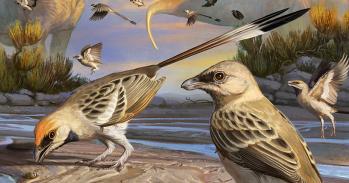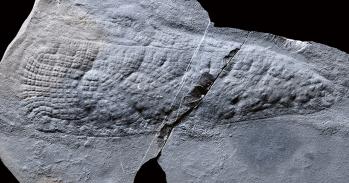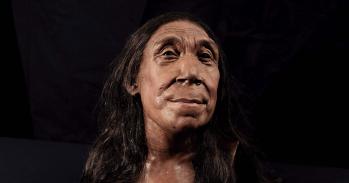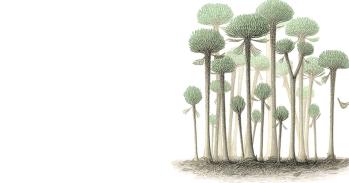
Were dinosaurs really the most exciting and interesting creatures ever to roam the planet? Zoologist Nick Crumpton tells the Cambridge Science Festival that it’s high time other prehistoric animals stepped out from the shadows.
Were dinosaurs really the most exciting and interesting creatures ever to roam the planet? Zoologist Nick Crumpton tells the Cambridge Science Festival that it’s high time other prehistoric animals stepped out from the shadows.
It’s time to pay more attention to all the other incredible creatures that lived before the time of the dinosaurs, during it, and after they were gone.
Nick Crumpton
Dinosaurs, as every schoolchild knows, were not just the most terrifying creatures ever to roam the Earth, but also the most exciting, and therefore the best. The peak of their golden age was one in which monstrous reptiles and carnivorous predators stalked the planet. True, not all of them were as big as houses, but some could grow up to 150 feet in length and more than 30 feet high. And the fiercest of the lot had no equal. Megaraptors, for example, possessed huge, sickle-like claws and powerful jaws with serrated teeth. Utahraptors, some palaeontologists have speculated, could run at speeds exceeding 50mph as they hunted down their prey in order to satiate their taste for flesh.
No wonder, then, that dinosaurs have been captivating the public for generations - ever since the Victorian age, in fact, when palaeontology really began to flourish as a science. Mammals, on the other hand, have always seemed a bit tame by comparison. In fairness, the biological class Mammalia makes some pretty decent contributions to the prehistoric record - think of the woolly mammoth, for example, or Smilodon (one of the many sabre-toothed tigers). In the final analysis, though, nobody ever made a film based on a book called “Pliocene Park”, nor a board game called “Lost Valley of the Marsupials”. Viewing figures for a TV series entitled “When Mammals Roamed America” would probably have left advertisers bitterly disappointed.
Yet while dinosaurs continue to thrill and intrigue us, Cambridge zoologist Nick Crumpton reckons that other prehistoric animals have been getting a raw deal. He argues that there are plenty such creatures that existed before, during and after the dinosaur age, and which, far from less interesting, are simply less well-known. In practice, they were – if not better – than certainly brainier, stealthier, and more capable of surviving in a wide range of different environments, than their dino counterparts.
In recent years, scientists have uncovered much more about these often overlooked specimens. Thanks to their efforts, there has never been a better moment to set the record straight in the contest between dinosaurs and other animals for our hearts and minds, and the time is ripe for the likes of the Phytosaur, Lycaenops, or even the humble Morganucodon to step out from the dinosaurs’ substantial shadows and claim their rightful place in public awareness. This Saturday (March 16), Crumpton will be on a mission to achieve exactly that at the Cambridge Science Festival. Not wishing to show bias towards either side in this epic clash of prehistoric heavyweights, his talk bears the modest and subdued title: “DINOBORES: Why mammals are way cool”.
“It’s a real shame that everyone knows about these incredible dinosaurs which evolved and ruled the Earth until 65 million years ago, but less about the amazing animals that in some cases predated them,” Crumpton says.
The idea for the talk came to him while he was co-authoring a children’s book, “Triassic Terrors”, which is being published by Flying Eye Books. “As we were writing it I realised that the most fun bits to write weren’t about dinosaurs, because during the Triassic period - about 200 million years ago - dinosaurs were really just evolving. There were, however, incredible mammals that we don’t hear of. The same is true of periods when dinosaurs really thrived, the Jurassic and Cretaceous. And that’s a pity, because some of the most important fossils for such mammals have been found right here in the British Isles.”
In truth, Crumpton’s interest lies not just with mammals, but with a whole host of animals which have traditionally barely been recognised because of the more established and charismatic appeal of the dinosaurs. Recent finds and thorough research, however, are allowing scientists to change that picture, and they are beginning to realise that the world hundreds of millions of years ago was populated by a far greater diversity of life than had previously been imagined.
This applies to prehistory before dinosaurs as well as during the dinosaur age. In the Permian period, for example (roughly 298 to 252 million years ago), we have evidence of animals such as Gorgonopsids - large, carnivorous, four-legged monsters with long, sabre-like fangs, strong rear legs, and a vaulted palate that allowed them to breathe when they grabbed their prey. The biggest was roughly the size of a large bear.
One of the best-known is Gorgonops itself, the dominant predator of its day, which thanks to its pillar-like rear legs probably moved at very fast speeds. Another, called Lycaenops, had powerful canine teeth in both its upper and lower jaws, which meant that despite measuring about three feet in size, it was capable of stabbing or tearing at much larger animals - although it probably stuck to hunting reptiles and other small prey most of the time. Its leg positioning was such that it was probably much more agile than many contemporary creatures, and able to outrun them to hunt them down.
Mammals are not the only interesting, but little-known creatures from around this time for which fossil evidence is growing. Today, for example, we are familiar with crocodiles and alligators, which are reptiles. Yet these are just two surviving examples of a much larger lineage called Pseudosuchia, which thrived during Triassic times, and in some cases were a much more fearsome prospect.
Take, for example, Ornithosuchus (literally “bird crocodile”), which was a sufficiently terrifying flesh-eater that for some time palaeontologists believed it was actually an ancestor to T-Rex. In fact, it wasn’t a dinosaur at all, and probably resembled a crocodile in looks to some extent, although worryingly it could stand on two legs when it needed to. It was also bigger – probably about four metres (13 feet) in length. Not something you want to run into, nor indeed away from, given that it could probably move pretty swiftly, as well.
The preeminence of dinosaurs really only began about 200 million years ago, when there was a sudden, devastating extinction event which probably wiped out something like half of the life on Earth. Until then, dinosaurs had only really had a bit-part in natural history, but thanks to “a quirk of fate”, as Crumpton puts it, their line recovered faster than most others, and so began the golden age of dinosaurs.
This, however, did not rule out the existence of mammals. For example, scientists have uncovered the remains of a small, squirrel-sized mammal that lived at least 125 million years ago, at a time when dinosaurs were dominant. This appears to have had a sizable, furry “patagium” - an extension of its skin, a bit like bat wings, and similar to that seen in flying squirrels today. Whatever this creature was, it was clearly gliding around the place in exactly the same age as the reptilian Pterosaurs.
Morganucodon, also a contemporary of dinosaurs, was an apparently less-spectacular, nocturnal creature. It lived about 205 million years ago and many remains attesting to its existence have been found in Glamorgan, in Wales. This small, furry animal had quite a long tail and a skull two to three centimetres in length, lived in a burrow, and might have looked a bit like a vole. It survived by eating insects, and other small animals.
As face-offs go, this appears to be something of a no-brainer. On the one hand, Megaraptors were large, terrifying and had big claws and pointy teeth. On the other, the likes of Morganucodon were certainly furry, possibly cute, and spent their day in a hole refusing to go outside.
Crumpton, however, argues that looks aren’t everything. “For some reason, people seem to have latched on to the idea of dinosaurs. But non-avian dinosaurs had small brains relative to their body-size, senses which weren’t as well developed, didn’t have endothermy as we do, and probably weren’t as good at parenting,” he complains. More constructively, he also points out that it was precisely the capacity of mammals to better these shortcomings which meant that, when the dinosaurs themselves were wiped out by another extinction event, probably caused by an asteroid hitting the Yucatan Peninsula 65 million years ago, mammals were able to fill the ecological niche they had left behind.
Once this happened, the mammals “really went to town”. Whales evolved where no fully aquatic dinosaurs had existed. Bats became so successful that today there are over 1,000 different species of bat on Earth. It wasn’t just the dinosaurs’ ecological niche that was occupied - everything was up for grabs.
So what was it that made mammals so successful, once they were given this chance to capitalise on the dinosaurs’ extinction? One significant asset was their relatively large brain size. “Bigger brains basically means better senses,” Crumpton explains. “Morganucodon was able to scamper around at night because it had better senses for coping in a nocturnal environment. Some of these animals also probably had a better sense of balance, which helped the flying squirrel-like creatures to glide through the air. Later these senses would enable them to communicate with each other, or co-ordinate hunts, like wolves. It’s highly unlikely, judging by the size of its brain, whether a T. Rex could have managed that.”
Then there was the fact that they were endothermic, or warm-blooded. Although there is some evidence for endothermy in a few groups of dinosaurs, the widespread warm-bloodedness found in mammals led to a range of physiological advantages. In particular, mammals had an increased metabolic rate and more energy available “on demand”, which meant that they could withstand temperature changes in a manner that dinosaurs could not. Nearly all reptiles today still bask on rocks in order to warm up in the sunshine. Mammals did not need to do this, and were far less vulnerable as a result.
As well as remarkable because they seem half-forgotten and exotic, Crumpton argues that prehistoric mammals and other animals were also amazing because they had qualities and capabilities that dinosaurs lacked. “I still love dinosaurs - they were what got me into biology when I was a kid and I don’t mean to resurrect an incorrect Victorian image of lumbering monsters dragging themselves slowly around the Earth,” he insists. “But now that I know more about life on Earth, it feels like it’s time to pay more attention to all these other incredible creatures that lived before the time of the dinosaurs, during it, and after they were gone.”
Nick Crumpton will be giving his free talk, “Dinobores: Why mammals are way cool”, on Saturday 16 March, from 10 - 10.45am in Arts School Room A on the New Museums Site, Pembroke Street, Cambridge. The event is one of a huge range of activities for all ages that are being organised for “Science On Saturday”, part of the Cambridge Science Festival.
This work is licensed under a Creative Commons Licence. If you use this content on your site please link back to this page.





